For the last six years, we’ve published the State of Remote Work report. We use this report to do a deep dive into the experience of remote workers around the world, their work structure, their struggles, and their career growth and pay.
This year, we had 3,000 remote workers respond to the State of Remote Work to help provide insights.
In this post, we’ll cover the top seven insights from the 2023 State of Remote Work. We’ll take a deeper look at some of the trends that currently exist in the remote workspace.
Thank you to Nomad List and Remote OK, who partnered with us on this year’s State of Remote Work report! Read the full report here:
Let's take a closer look at what this year's report has to say about the state of remote work.
1. Remote work continues to be perceived as very positive.
Remote work has its fair share of critics. Still, those who work remotely perceive it very well. A whopping 98 percent of respondents want to work remotely for the rest of their careers. Another 98 percent would also recommend remote work to others.
We ask these questions to try and get a sense of how remote workers are feeling about remote work, and consistently we learn that they want to keep working remotely and they would recommend it to others.
These two responses are up slightly from 97 percent in 2022.
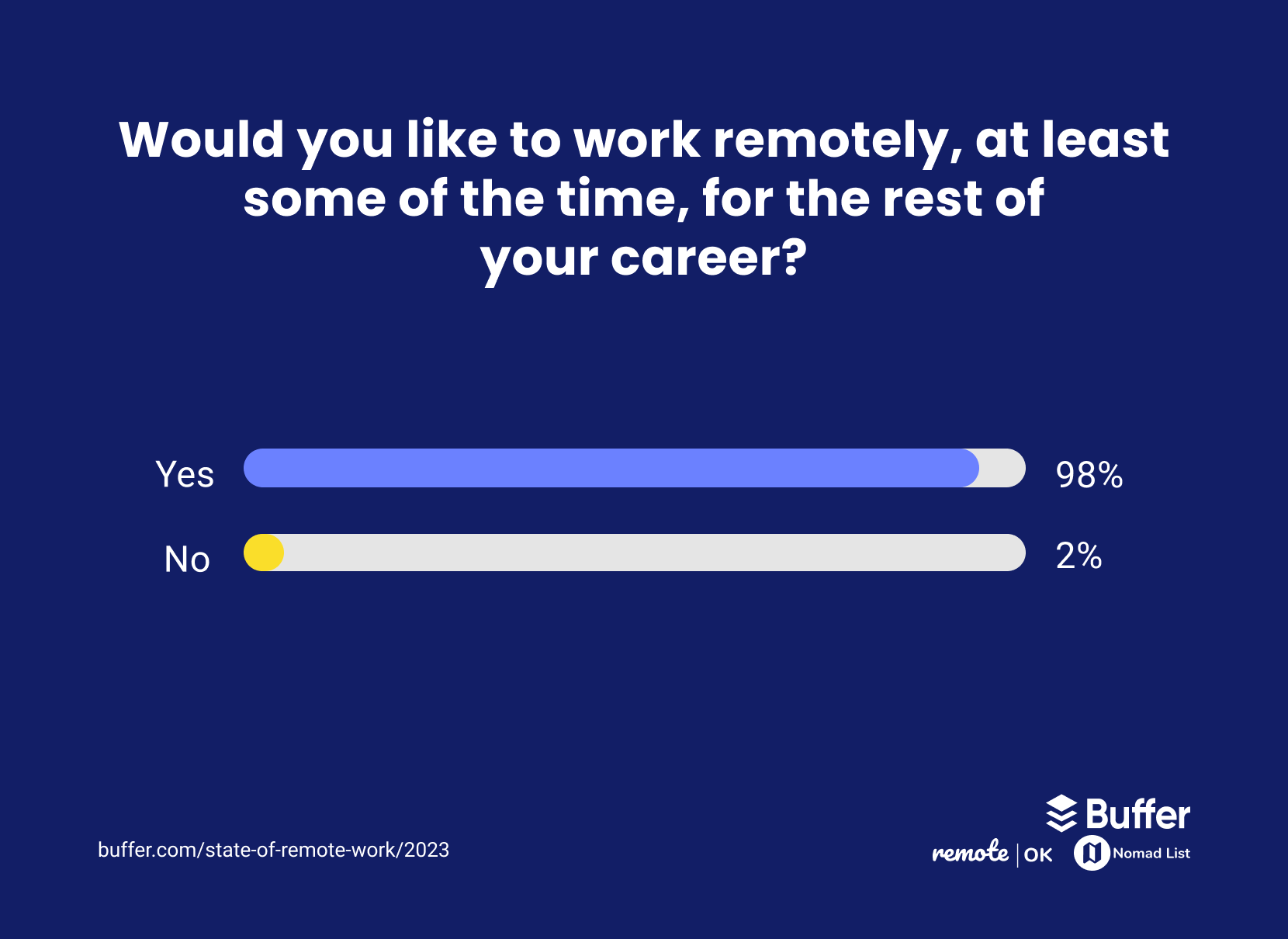
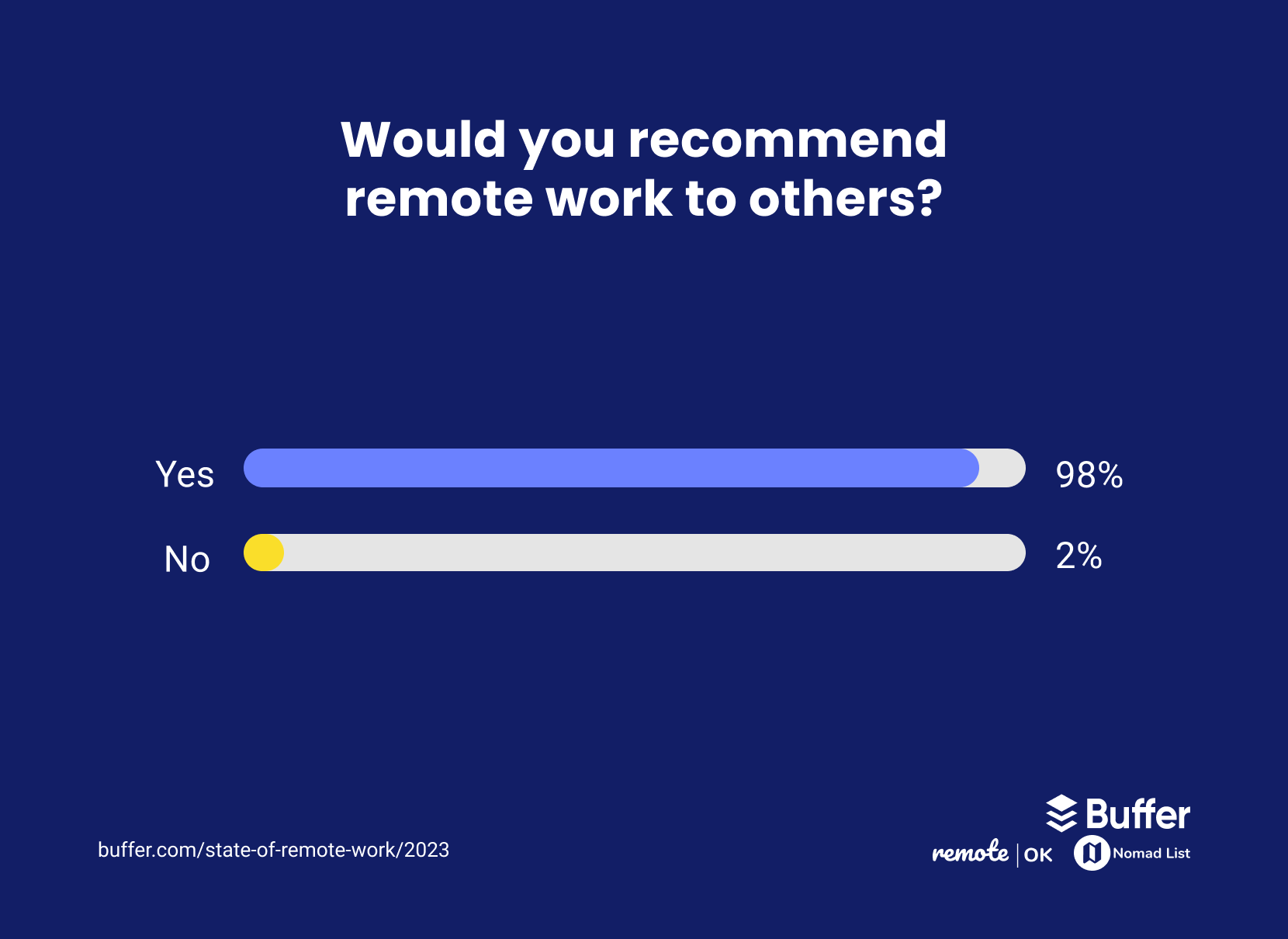
Another indicator for remote work is that we directly ask respondents about their experience. Again, we had great results — 91 percent of respondents report having a positive experience and just 1 percent described their experience with remote work as negative. Respondents were most likely to select very positive with 68 percent of respondents selecting it, and 23 percent selected somewhat positive.
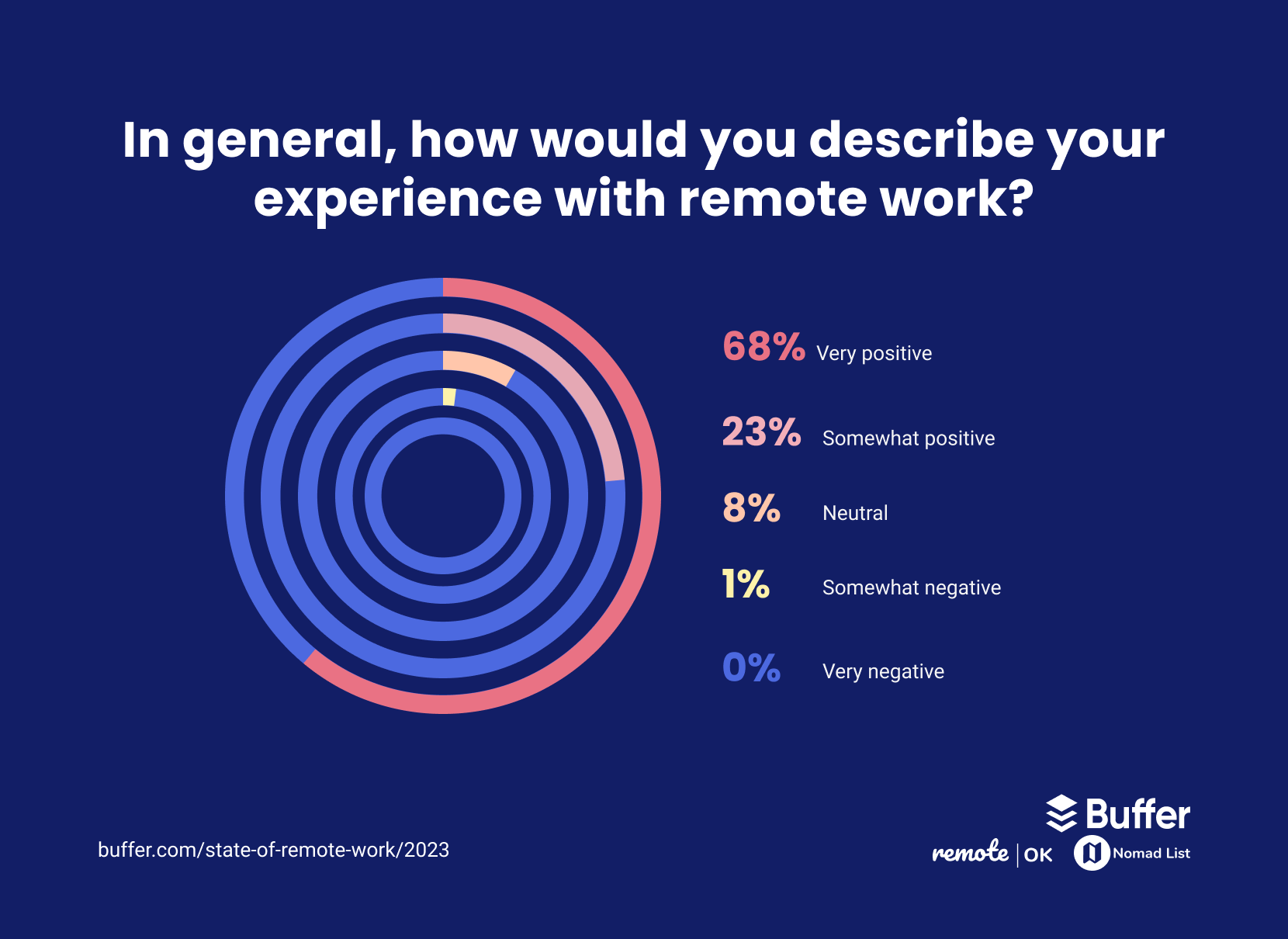
Overall, regardless of the critics, people who work remotely overwhelmingly want to continue working remotely, we see this year after year. This is something to consider as some organizations are considering the return to the office. We’ll get into that next.
2. Remote workers don’t want a hybrid setup
In 2020, remote work became the norm out of necessity. In 2021 and 2022, the conversation largely revolved around the return to the office, or how to successfully adopt a hybrid approach to work.
Based on this year’s responses, we can see that remote workers don’t want a hybrid setup.
When asked about their current work structure, most of our respondents (64 percent) were fully remote, another 18 percent were hybrid and remote first, 9 percent were hybrid and office occasional (required or encouraged to be in the office), and another 9 percent were hybrid and office-first with remote work allowed.
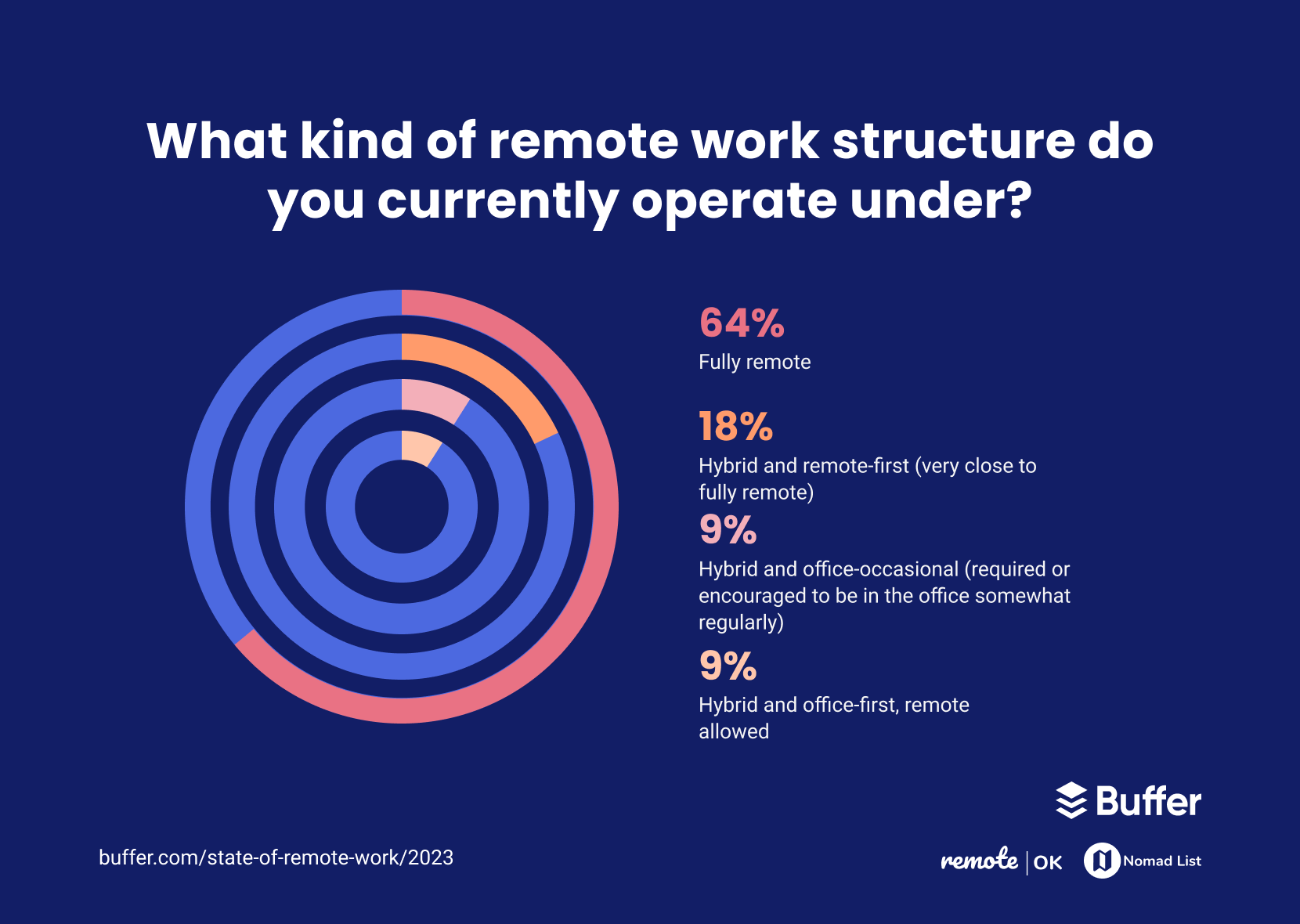
In the next question, we asked about the structure that those same respondents would like to have, and the response was clear — 71 percent would prefer fully remote, and 20 percent would choose hybrid but also remote-first, which is very close to being fully remote. Just 6 percent selected hybrid and office occasional, and another 2 percent selected hybrid and office first, with 1 percent selecting fully office based.
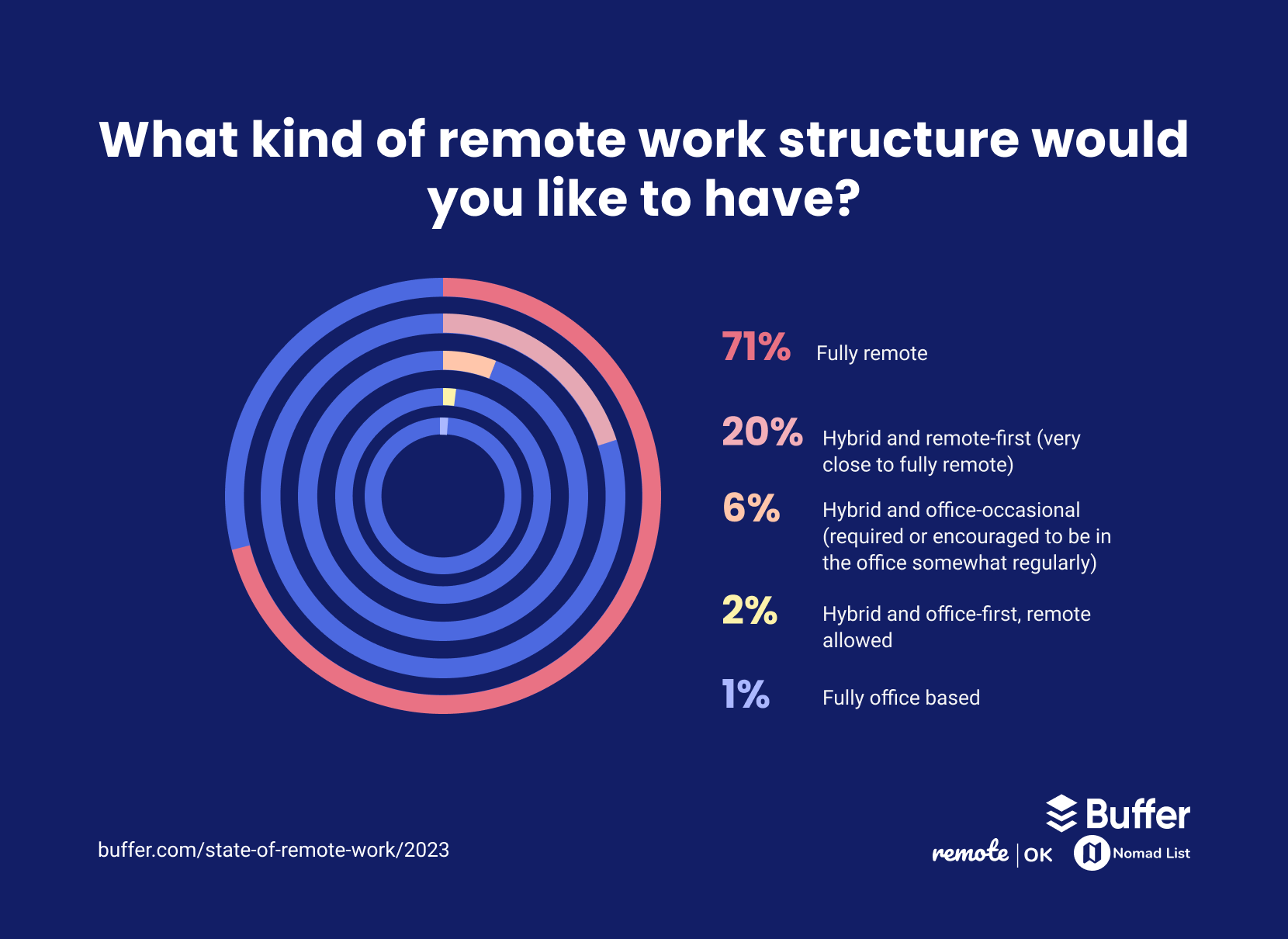
These trends have all increased from 2022 as well. In 2022 we had fewer respondents who were already fully remote (49 percent) and fewer who selected that they preferred a fully remote setup (56 percent).
After several years where the hybrid work structure has been explored by many large organizations, these results could indicate that the hybrid setup has not been working for remote workers and they prefer being fully remote or as close to fully remote as possible.
3. Flexibility continues to be the biggest benefit of working remotely
Unsurprisingly, the top benefit of remote work remains flexibility. We get specific about what respondents mean when they say flexibility, though. For 22 percent, the biggest benefit of remote work is the flexibility in how they spend their time, for 19 percent it’s the flexibility to live where they choose, and for 13 percent it’s the flexibility to choose their work location.
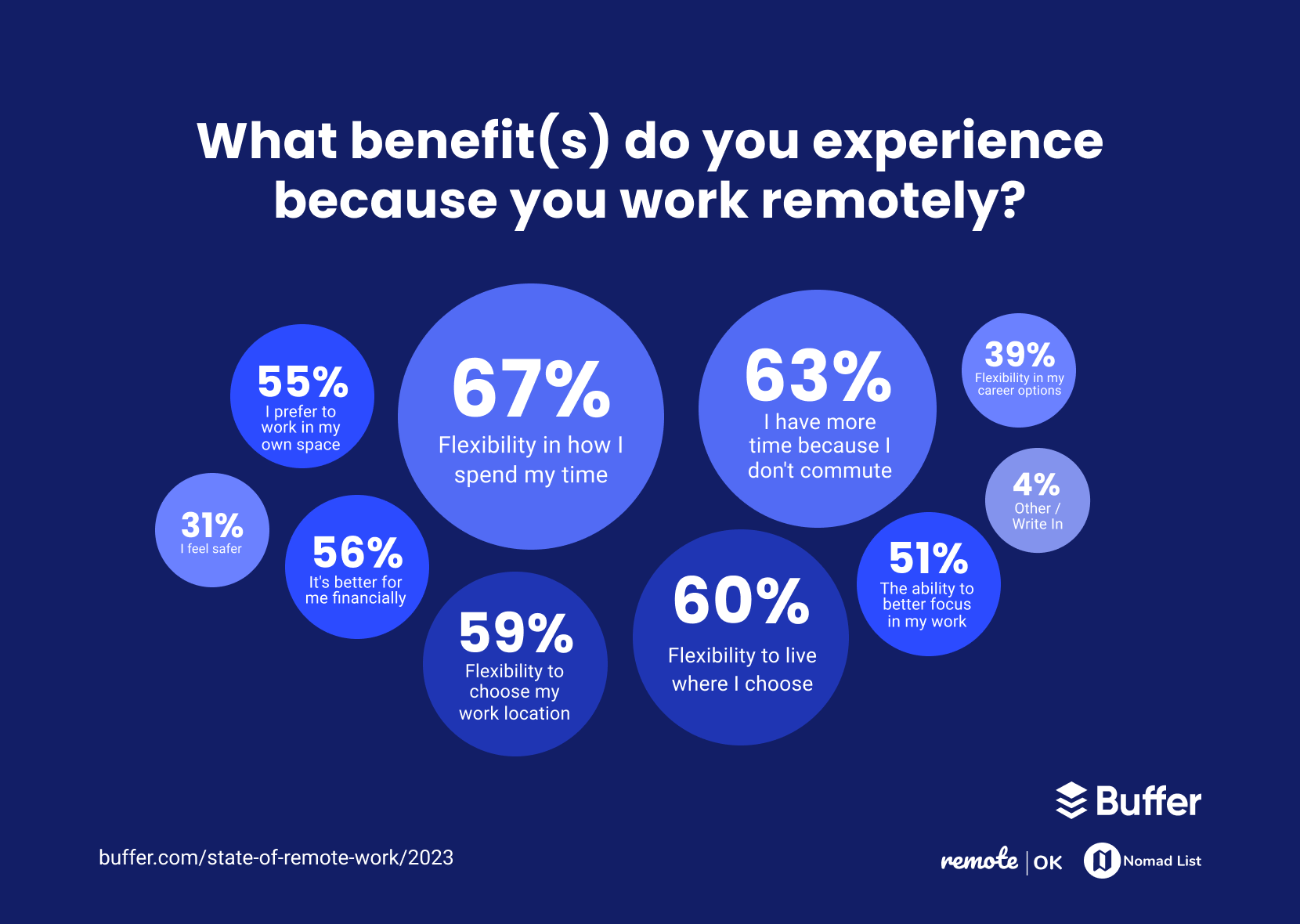
We’ve seen many examples of Buffer teammates embracing the flexibility we offer to live and work differently and they’ve found a lot of happiness in the setup. One teammate has been a digital nomad ever since joining the team.
This flexibility lends itself differently to everyone and we’ve seen other groups like parents use remote work to set up their schedules to work better for their families as well.
4. One in three remote workers reports staying home too often because they don’t have a reason to leave
We always dig into the biggest struggles of remote work alongside the biggest benefits — and the top responses are always shifting. For several years, we saw communication and collaboration were the biggest challenges for remote workers followed by loneliness, we saw loneliness spike in 2020, and then not being able to unplug led the way in both 2021 and 2022 with loneliness as a close second.
This year, we added an option to the survey that we had seen spoken about online and in our own circles when it comes to struggles with working remotely — “I stay home too often because I don’t have a reason to leave.” This option ended up being the most likely response with 33 percent of respondents selecting it as a struggle that they have. When asked about their biggest struggle from the list, staying home too often remained in the lead with 21 percent of remote workers selecting it.
The next most selected struggle for remote workers was loneliness, with 23 percent of remote workers selecting it overall and 15 percent of remote workers selecting it as their top struggle from the list. These two struggles go hand in hand and paint a picture of how the reality of remote work can be very challenging.
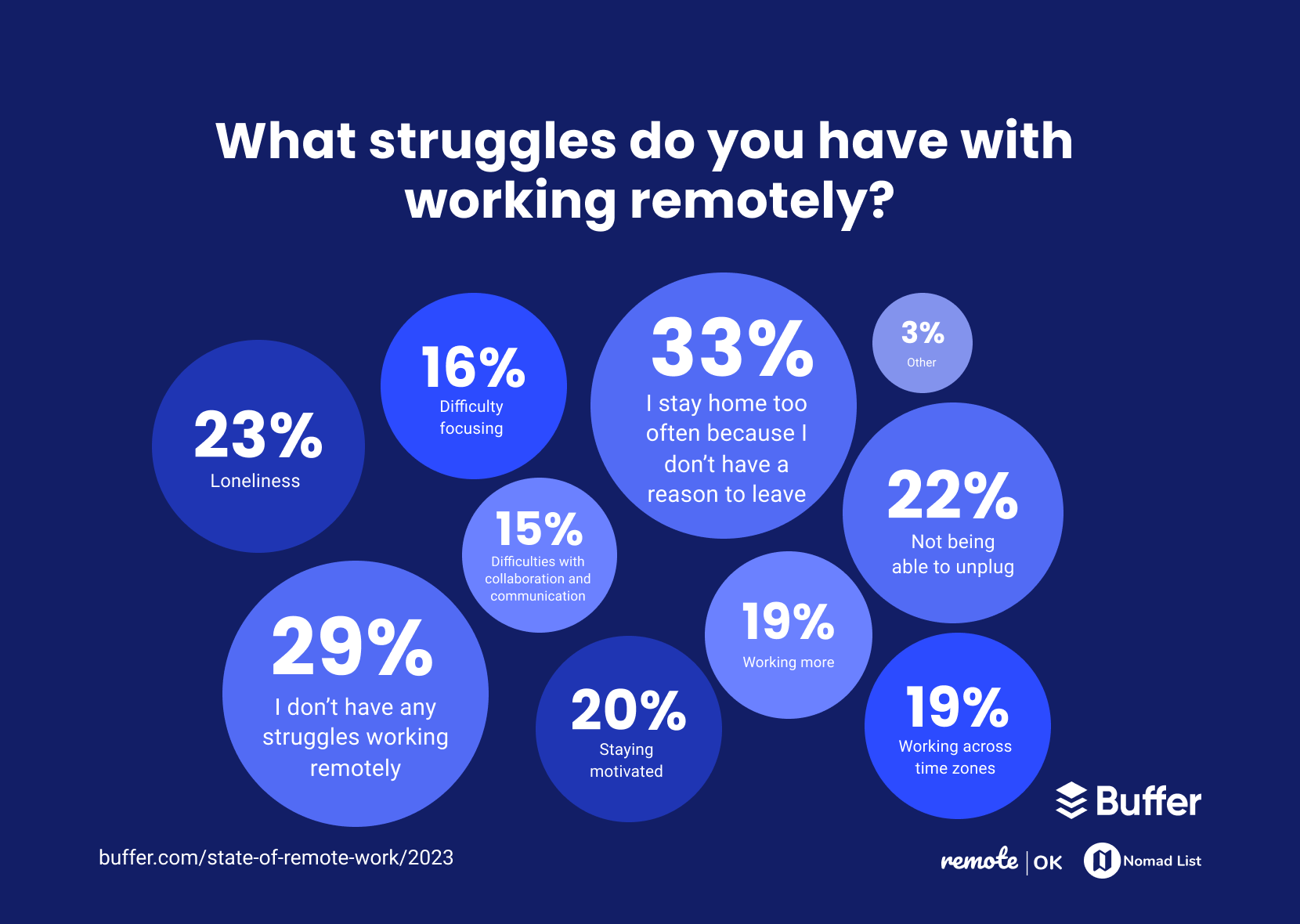
5. Remote workers find work boundaries important but are only moderately successful with setting them
While 71 percent of respondents say it’s very important to set work boundaries, remote workers are only moderately successful.
Eighty-one percent of remote workers claim to check work emails outside of work hours, including 63 percent who do so on weekends and 34 percent while on vacation. Another 48 percent say they frequently work outside of traditional work hours, and 44 percent of remote workers say they have worked more this year compared to last year. Finally, 22 percent report not being able to unplug as their biggest challenge with remote work.
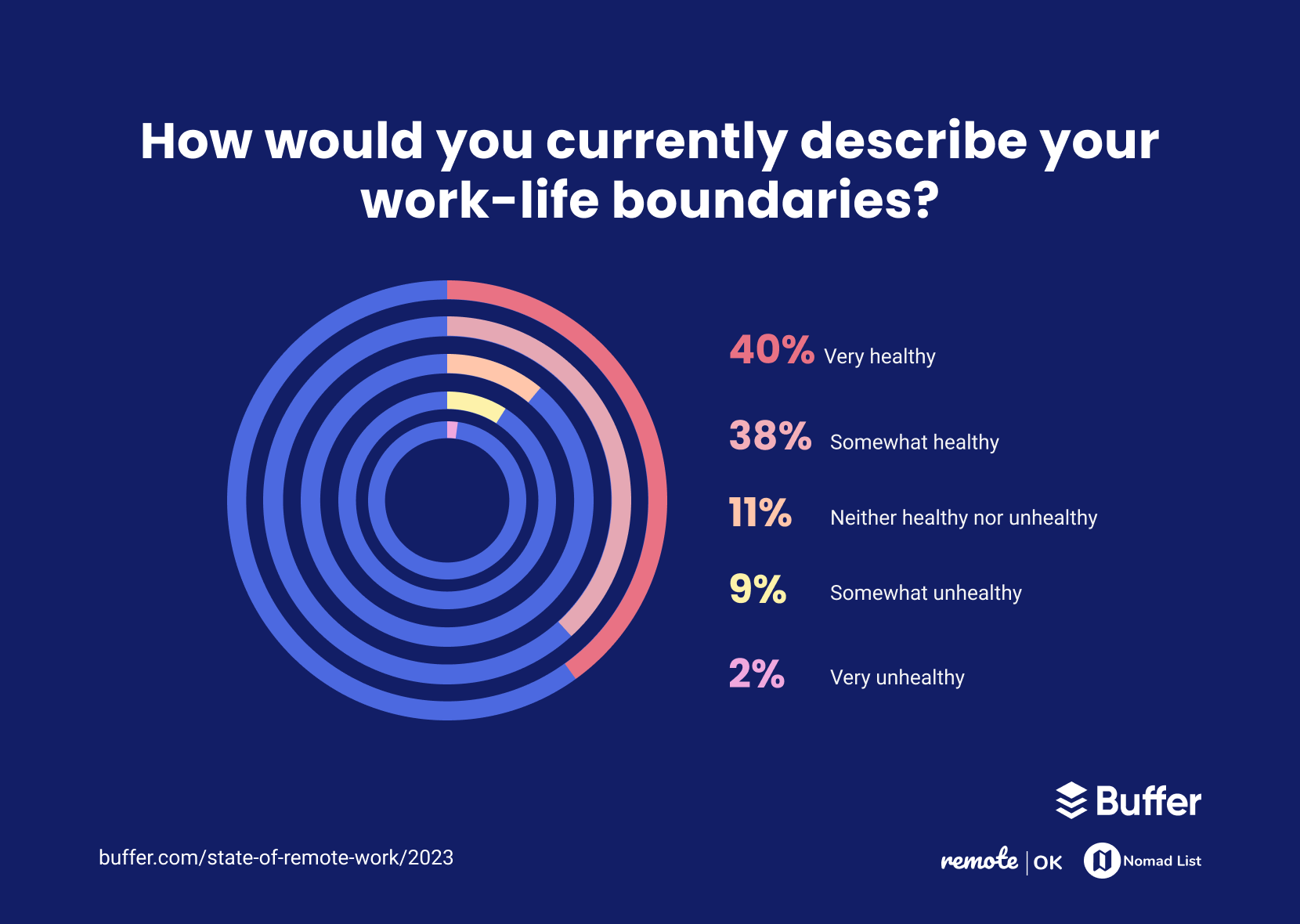
Organizations and leaders have a role to play in work boundaries as well by ensuring that communication expectations are clear, especially on remote teams where your devices act as a workspace but also personal space. Here’s how we set up agreements for how we communicate on Slack at Buffer.
6. Remote workers are split on if career growth is more difficult remotely, but it’s trending toward easier
In 2022’s report, we added a question to learn more about career growth for remote workers — a trending topic at the time as some claimed remote work would be detrimental to anyone’s career. In that report, 45 percent of respondents said that remote work did make career growth more difficult, just 14 percent said remote work made career growth easier, and the remaining 41 percent said it had no impact.
This year, we asked the question again, and we got a very different response. We saw a huge increase in the number of people who selected that remote work made career growth easier — from 14 percent to 36 percent. We also saw the group that found career growth more difficult decrease from 45 percent in 2022 to 28 percent in 2023.
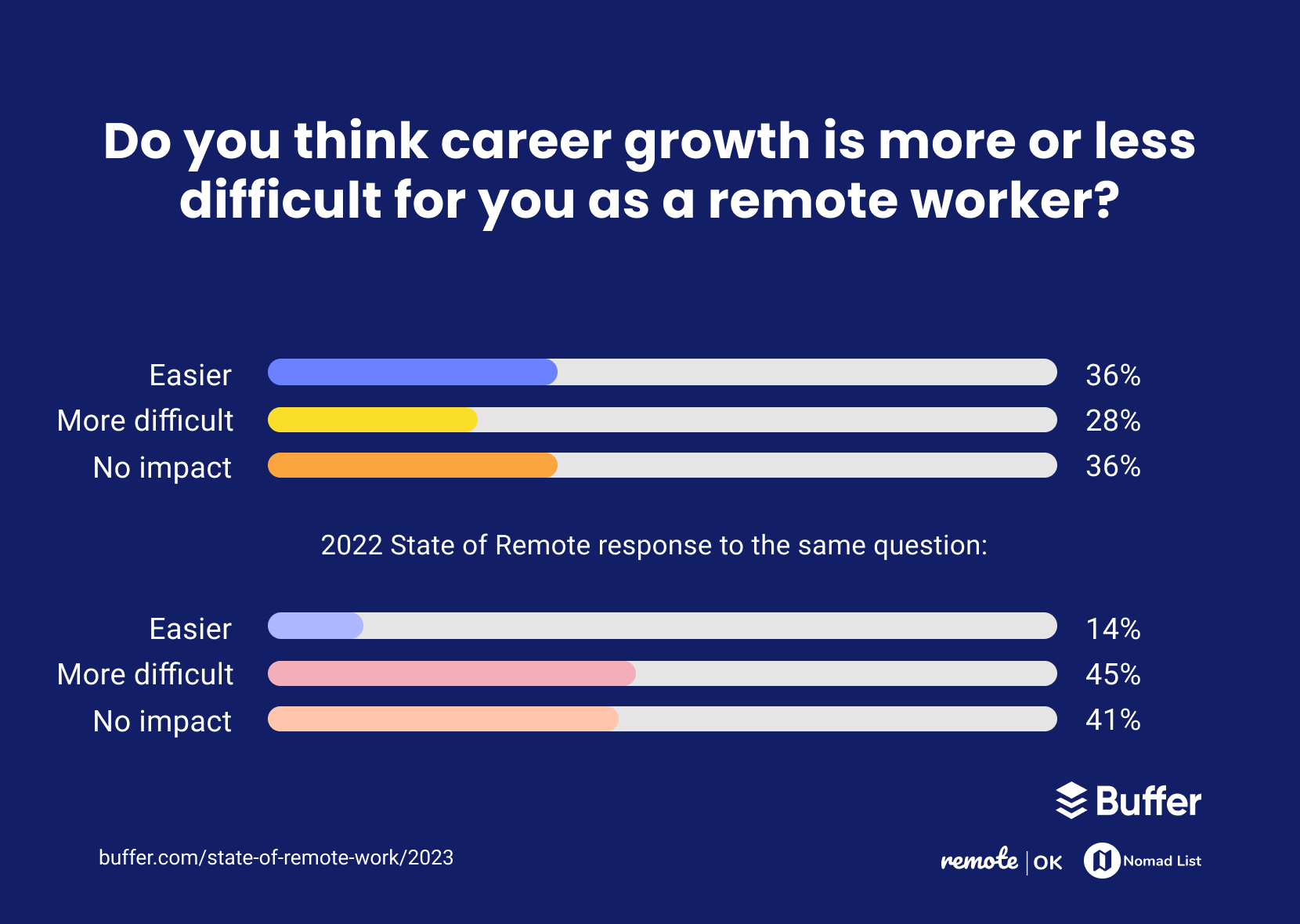
These trends are overall positive, as remote workers are either saying career growth is easier or that remote work has no impact on their career growth. The end results though are still split with 28 percent finding career growth more difficult while remote and 36 percent finding it easier.
The group who find remote work easier for their career growth were most likely to select that the reason they felt that was that they were measured on their output and impact instead of their time in the office, as well as the fact that all employees are on a level playing field because they are all remote. Career frameworks can be a massive help here.
On the flip side, the group who found remote work more difficult said it was because they feel like if they aren’t seen they aren’t thought of for new opportunities, as well as because they don’t know how to promote their own success and they feel left out of organic conversations. This last one hints at a gap between fully remote workers and hybrid workers — and when we looked into that gap it was there. People who selected that they work hybrid and office occasional or hybrid and office first were more likely to select that remote work was more difficult than their fully remote or hybrid and remote first counterparts.
The feeling that career growth is more difficult for hybrid workers is potentially another reason that remote workers prefer not to work in a hybrid setup unless it is remote first.
7. Remote workers feel connected to their colleagues, and are more energized and engaged
Another criticism is that remote workers don’t feel connected to their colleagues and aren’t engaged at work. We can prove this isn’t true.
From our survey, 75 percent of remote workers feel connected to their colleagues, even though a majority of the respondents work across time zones. More than half of respondents (58 percent) said that they feel engaged about their job, compared to 30 percent who are unengaged.
Another positive indicator on this front, compared to a year ago, almost half of remote workers say they are feeling more energized. Twenty-one percent report feeling burnt out and 31 percent report no change.
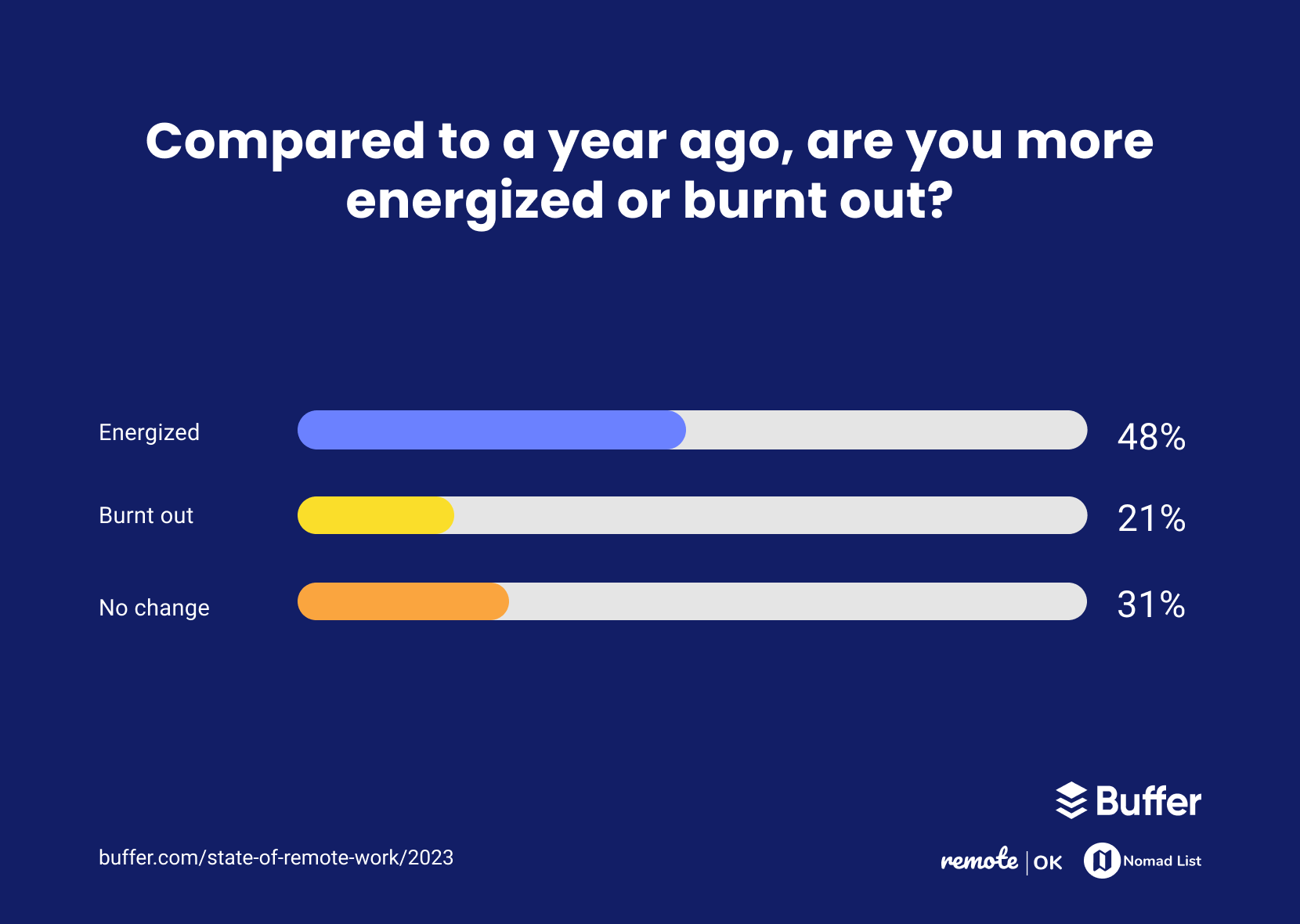
Overall, this report has felt like a strong indicator of the stability of remote work in today’s workplace. Many remote workers say that their company is permanently allowing some form of remote work, and remote work’s benefits seem to outweigh the struggles as remote workers continue to want to work remotely for the rest of their careers.
What do you want us to ask about next year? Send us a tweet or pop into our community.
Try Buffer for free
190,000+ creators, small businesses, and marketers use Buffer to grow their audiences every month.




